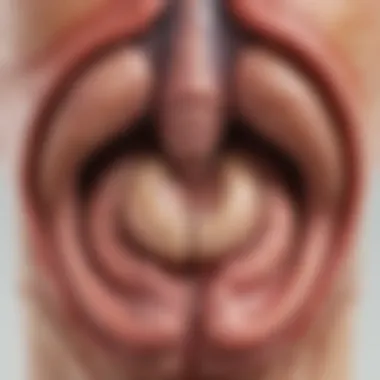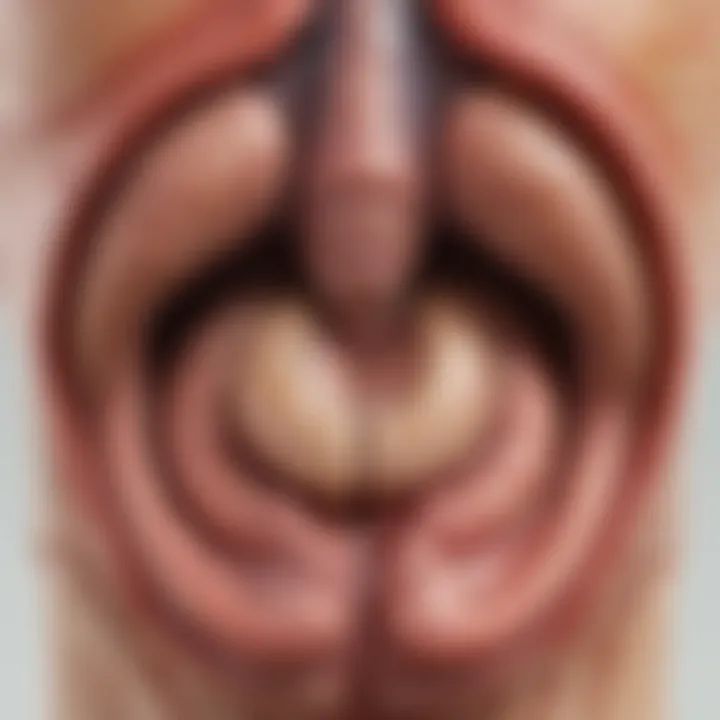Exploring the Corpus Uteri: Structure and Function


Intro
The corpus uteri, commonly known as the body of the uterus, plays a vital role in female reproductive health. It supports the various processes involved in conception and gestation, providing a nurturing environment for the developing embryo. Understanding the anatomy and functions of this organ is crucial for both medical professionals and researchers. Its significance extends beyond just reproductive aspects, linking to various medical conditions that can affect women's health.
In recent years, there have been notable advancements in understanding the corpus uteri. This article aims to explore these aspects in detail, emphasizing its structure, physiological functions, and the clinical significance of the corpus uteri. By analyzing common disorders, diagnostic techniques, and emerging medical interventions, we offer a comprehensive overview tailored for students, healthcare providers, and researchers.
Research Overview
Key Findings
Recent studies have illustrated the complex architecture of the corpus uteri. The tissue is richly supplied with blood vessels, enabling it to respond dynamically to hormonal changes. It has been found that disruptions in normal function can lead to conditions such as endometriosis or uterine fibroids, which are prevalent among women of reproductive age.
- Anatomical structure: The corpus uteri consists of three main layers: the endometrium, myometrium, and perimetrium. Each layer has distinct roles in the reproductive process.
- Physiological roles: The corpus is essential for menstruation, implantation of the embryo, and development of the fetus during pregnancy.
- Clinical implications: Disorders linked to the corpus uteri not only affect reproductive health but can also have far-reaching impacts on overall well-being.
Study Methodology
Different methodologies have been deployed in researching the corpus uteri. Clinical studies often involve imaging techniques such as ultrasound or MRI to visualize anatomical changes. Histological analyses are also performed on tissue samples to observe the cellular characteristics and to identify pathological changes.
- Qualitative assessments: Checking for structural abnormalities at the cellular level.
- Quantitative metrics: Measuring the dimensions and blood flow of the corpus during various menstrual cycle phases.
Background and Context
Historical Background
Historically, the understanding of the corpus uteri has evolved significantly. Early notions treated it primarily as a reproductive organ, with attention focused on menstruation and childbirth. Over time, research expanded to encompass a broader array of functions and behaviors.
Current Trends in the Field
Presently, there is a growing focus on the interplay between hormonal regulation and uterine health. Investigations repeatedly highlight conditions that can arise from hormonal imbalances, such as polycystic ovary syndrome. Advances in technological approaches, including artificial intelligence, are emerging as tools to enhance diagnostic processes.
This discussion on the corpus uteri will further develop in the sections that follow, delving into its structure and function alongside the various disorders that may arise and the medical responses to these challenges.
Prologue to the Corpus Uteri
The corpus uteri, commonly known as the body of the uterus, plays a central role in female reproductive health. It is imperative to understand its structure and function, as many aspects of women's health are closely tied to this organ. This section introduces the corpus uteri, laying the foundation for further exploration of its anatomical features and physiological roles.
In this article, we focus on two primary areas within 'Introduction to the Corpus Uteri.' First, we define the corpus uteri, explaining its significance within the reproductive system. Second, we provide an anatomical overview, summarizing its location and primary characteristics. By comprehensively addressing these areas, readers will gain a clearer perspective of the corpus uteri's relevance to women's health.
Definition and Significance
The corpus uteri is the main body of the uterus, distinct from the cervix, which is the lower part of the organ. It serves multiple functions, including providing a space for fetal development during pregnancy and playing a critical role during the menstrual cycle. Understanding the definition of the corpus uteri illuminates its importance in female reproductive physiology.
From a clinical perspective, abnormalities or diseases related to the corpus uteri can lead to significant reproductive issues. Disorders such as uterine fibroids and endometriosis can disrupt normal function, affecting fertility and overall health. Proper awareness of the corpus uteri's role thus forms a critical part of both healthcare education and patient management.
Anatomical Overview
Anatomically, the corpus uteri is a pear-shaped structure situated centrally in the pelvis. It connects to the cervix at its lower end and expands into the fallopian tubes at the top. The corpus is wider in the upper region and tapers downwards to connect with the cervix. This arrangement is crucial for the transport of sperm toward the fallopian tubes and the passage of menstrual fluid out of the body.
The corpus uteri is composed of three major layers: the endometrium, myometrium, and perimetrium. Each layer has distinct functions that contribute to the overall capabilities of the uterus. The endometrium is the innermost lining that thickens and sheds during the menstrual cycle. The myometrium is the muscle layer responsible for contractions during labor, while the perimetrium serves as the outer protective covering.
"The corpus uteri must function harmoniously with other reproductive organs to maintain women's health and fertility."
By delving into both the definition and anatomical structure of the corpus uteri, one can appreciate its multifaceted role in reproductive health. Understanding these basic concepts is essential for grasping the more complex physiological processes and potential disorders discussed in later sections of this article.
Anatomy of the Corpus Uteri
Understanding the anatomy of the corpus uteri is crucial for comprehending its physiological functions and clinical significance. The structure encompasses key elements that define its role in reproductive health.
The corpus uteri represents the main body of the uterus, playing a pivotal role in menstruation, pregnancy, and hormone regulation. A detailed knowledge of its structure aids in the diagnosis and treatment of various conditions affecting the uterus. Thus, it is essential to explore its general architecture and the specific histological layers that contribute to its overall functionality.
General Structure
The corpus uteri is often described as pear-shaped, but this does not fully capture its complexity. The size can vary among individuals but typically measures around 7-8 cm in length and 5-6 cm in width. The outer surface appears smooth and is covered by the perimetrium, which protects the inner tissues.
Importantly, the cavity of the corpus uteri is lined with the endometrium, which undergoes significant changes during the menstrual cycle. The myometrium, a thick layer of smooth muscle, constitutes the bulk of the uterine wall, providing the necessary contractions for expelling menstrual blood and delivering a child.
This intricate structure supports the various physiological processes linked to reproductive health.


Histological Layers
The corpus uteri comprises three distinct histological layers that each contribute to its overall function.
Endometrium
The endometrium is a highly specialized tissue that plays an integral role during the menstrual cycle and pregnancy. It consists of a functional layer that thickens and sheds in response to hormonal fluctuations. This cyclical change is crucial for successful implantation of the embryo.
The key characteristic of the endometrium is its regenerative capability. After menstruation, it rebuilds itself under the influence of estrogen, ensuring a suitable environment for potential fertilization.
However, its unique feature can also lead to certain disorders. Inadequate remodeling can result in various pathologies, such as endometriosis and uterine polyps, impacting reproductive outcomes.
Myometrium
The myometrium is another vital layer composed of smooth muscle fibers. Its primary function is to facilitate contractions during labor and menstruation. This layer is thicker than the endometrium and provides structural support to the uterus.
The key characteristic here is the muscular arrangement, which varies in direction, allowing for optimal contraction patterns. This structural advantage aids in efficient fetal expulsion during childbirth. However, conditions like fibroids can disrupt its normal function, leading to complications.
Perimetrium
The perimetrium is the outermost layer of the corpus uteri, serving as a protective covering. It consists of a serous membrane that allows for movement between the uterus and surrounding structures.
Its primary function is to provide a barrier against infection and trauma while facilitating the expansion of the uterus during pregnancy. While it may not be directly involved in reproductive processes, its integrity is essential for overall uterine health.
Vascular Supply
The vascularization of the corpus uteri is essential for its function and health. Blood supply primarily comes from the uterine arteries, which branch off from the internal iliac arteries. This rich vascular network ensures adequate nutrients and oxygen are delivered, supporting the metabolic needs of the tissues, particularly during the menstrual cycle and pregnancy. Proper vascular supply is vital for maintaining the endometrial lining and facilitating uterine contractions.
Physiology of the Corpus Uteri
The physiology of the corpus uteri plays a vital role in understanding how the human reproductive system functions. This section discusses its significance concerning regulation of the menstrual cycle, the organ's role in implantation, and the influence of different hormones. These physiological aspects are not only crucial for normal reproductive health but also for identifying disorders related to the corpus uteri.
Menstrual Cycle Regulation
The menstrual cycle is a complex interplay of hormonal signals that prepare the body for potential pregnancy. The corpus uteri, especially through its endometrial layer, undergoes significant changes during the cycle. Typically lasting about 28 days, this cycle involves the thickening of the endometrium in response to estrogen, followed by its shedding if no implantation occurs. The regularity and health of this cycle are essential for fertility. Any disruption can result in irregular periods or conditions such as amenorrhea.
Role in Implantation
Implantation is a critical process whereby a fertilized egg adheres to the endometrial lining of the corpus uteri. An optimal endometrial environment is necessary for this to happen. The endometrium must be sufficiently thickened and rich in blood supply to support the embryo's growth. If implantation is successful, the corpus uteri will continue to transform to accommodate the developing fetus. Understanding this role can illuminate the impact of various disorders that can interfere with this process, such as uterine fibroids or endometriosis.
Hormonal Influences
Hormonal influences are central to the functioning of the corpus uteri. The most significant hormones involved are estrogen and progesterone. These hormones significantly affect the structure and function of the corpus uteri throughout the menstrual cycle.
Estrogen Effects
Estrogen primarily prepares the endometrium for potential future implantation. It promotes the proliferation and thickening of the endometrial lining, making it more receptive to a fertilized egg. The influence of estrogen is observed in various stages of the menstrual cycle. A key characteristic of estrogen effects includes its ability to enhance blood flow to the uterus, supporting nutrient supply. However, excessive levels of estrogen can lead to conditions like endometrial hyperplasia, which might progress to more severe issues.
Progesterone Effects
Progesterone stabilizes the endometrium after ovulation, ensuring a suitable environment for a fertilized egg. It functions mainly to keep the lining intact and supportive during the possible implantation of an embryo. The distinct quality of progesterone effects is its preventive action against menstrual bleeding during early pregnancy. Yet, low levels of progesterone can lead to complications, such as miscarriages.
The health of the corpus uteri is intimately tied to hormonal balances, underscoring the need for carefully monitoring these hormones in women's health.
Understanding these components of physiology is crucial for grasping how disruptions in the corpus uteri can lead to various reproductive health issues. This knowledge will serve as a foundation as we explore related disorders and treatment options in subsequent sections.
Common Disorders of the Corpus Uteri
The corpus uteri is vital for reproductive health, and disorders affecting it carry significant implications for women’s health. Recognizing these disorders is crucial for timely diagnosis and intervention. This section will examine three prominent disorders: uterine fibroids, endometriosis, and uterine cancer. Each condition presents unique challenges and requires specific approaches to treatment and management, as they can profoundly affect quality of life and fertility.
Uterine Fibroids
Symptoms and Diagnosis
Uterine fibroids, also known as leiomyomas, are benign tumors commonly found in the uterus. Identifying symptoms is essential for effective diagnosis. Common symptoms include heavy menstrual bleeding, pelvic pain, and pressure symptoms affecting the bladder and bowels. Diagnosis typically involves imaging techniques like ultrasound or MRI.
Key characteristics of symptoms and diagnosis include the nature of symptomatology, which can vary based on the size and location of the fibroids. Many women may be asymptomatic, making awareness of this condition vital. Understanding the diagnostic landscape helps healthcare providers offer better patient care.
A unique feature of this approach is that imaging tools are non-invasive and can provide clear visualizations. However, there may be limitations, such as insufficient imaging clarity in certain cases, which may require additional diagnostic methods.


Treatment Options
Treatment options for uterine fibroids encompass both medical and surgical interventions. Pharmacological treatments can include hormonal therapies aimed at managing symptoms. Surgical options could range from myomectomy, which removes fibroids while preserving the uterus, to hysterectomy for more severe cases.
The key characteristic of treatment options is their adaptability to individual patient needs. Some may prefer conservative management if symptoms are mild, while others may require aggressive interventions for debilitating symptoms or fertility concerns.
A unique feature of this discussion is the need for a multidisciplinary approach, involving gynecologists and potentially oncologists if the fibroids are complex. Notably, the impact of treatment may vary, leading to both physical and emotional ramifications, influencing choices for women.
Endometriosis
Pathophysiology
Endometriosis is a condition where endometrial-like tissue grows outside the uterus. This can lead to chronic pain and infertility. Understanding the pathophysiology is important as it underpins diagnosis and management. The key characteristic is the ectopic tissue response to hormonal fluctuations, leading to inflammation and the formation of adhesions.
The unique feature of the pathophysiology is its complexity—it’s not simply a disease of the reproductive system but rather connects to a broader systemic response that can affect various bodily functions. This makes it an important focus for future research to uncover more about its etiology and consequence.
Management Strategies
Managing endometriosis requires a tailored approach. Treatment can involve pain management strategies, lifestyle modifications, hormonal therapy, and surgery. The key characteristic of these strategies is that they aim to alleviate symptoms and improve quality of life. Since endometriosis symptoms vary widely, a comprehensive management plan is necessary.
A unique feature of management strategies lies in their multifaceted nature, which may include psychological support alongside medical treatment. This acknowledges the significant emotional toll endometriosis can impose and suggests that addressing mental health is equally important.
Uterine Cancer
Risk Factors
Uterine cancer is a significant concern in women’s health. Risk factors include obesity, age, hormonal factors, and family history. A thorough understanding of these risk factors can guide screening and preventive measures. The key characteristic of identifying risk factors is that it allows for a more personalized approach to care.
A unique feature of focusing on risk factors is the potential for proactive health measures. For example, weight management or hormonal evaluations could mitigate risks for developing uterine cancer. Recognizing these factors cultivates a preventive mindset among patients and healthcare providers.
Early Detection Techniques
Early detection is crucial in improving outcomes for uterine cancer. Techniques include transvaginal ultrasound and endometrial biopsy. The key characteristic of these techniques is their ability to identify abnormalities in the early stages of the disease. This can lead to timely intervention and increased survival rates.
A unique feature of early detection techniques is their accessibility in clinical settings. Some procedures are minimally invasive, which enhances patient comfort and compliance. However, there may be drawbacks, such as false positives that can lead to unnecessary anxiety or procedures.
Understanding common disorders of the corpus uteri fosters better awareness and encourages women to seek medical advice for symptoms that could indicate serious issues. The overall goal is to enhance reproductive health and inform further research in this critical area.
Diagnostic Approaches
The diagnostic approaches to the corpus uteri are critical for identifying issues related to its structure and function. Understanding these methods is essential not only for medical practitioners but also for students and researchers interested in reproductive health. Diagnostic techniques can reveal a variety of conditions, from benign disorders such as fibroids to malignant tumors like uterine cancer. By utilizing modern imaging and biopsy procedures, healthcare providers can accurately assess and manage these health concerns.
Imaging Techniques
Ultrasound
Ultrasound is often the first-line imaging technique used in evaluating the corpus uteri. This non-invasive procedure harnesses sound waves to create detailed images of the uterus. One key characteristic of ultrasound is its safety, as it does not involve ionizing radiation. This makes it a popular choice for routine examinations and monitoring in women of all ages. The unique feature of ultrasound is its real-time imaging capability, allowing for quick assessments of structural abnormalities. Its advantages include cost-effectiveness and its ability to be performed in an office setting without the need for sedation. However, ultrasound may have limitations in visualizing certain pathologies, particularly when the patient has a high body mass index or in cases of complex uterine morphology.
MRI
Magnetic Resonance Imaging (MRI) is another valuable tool for assessing the corpus uteri, especially in cases where detailed visualization is necessary. One significant aspect of MRI is its high-resolution imaging capabilities, which can delineate soft tissue structures more effectively than ultrasound. MRI is beneficial for its ability to provide comprehensive information regarding the extent of lesions and surrounding tissues. The unique feature of MRI lies in its contrast agents, which enhance the visibility of specific abnormalities. The advantages of MRI include its non-invasive nature and excellent soft-tissue contrast. However, it is costlier than ultrasound and requires more time for imaging, which might not be suitable for all patients due to claustrophobia or the presence of metal implants.
CT Scan
Computed Tomography (CT) scans are less commonly used for evaluating the corpus uteri but still play a role in specific contexts. The key characteristic of a CT scan is its speed; it can provide rapid results, making it useful in emergency settings. CT scans offer detailed cross-sectional images and can reveal both the uterus and surrounding structures effectively. The unique advantage of CT lies in its ability to visualize complex anatomical relationships, which can aid in surgical planning. However, the use of ionizing radiation makes it less desirable for routine screenings. Moreover, CT scans often require contrast material, which may not be suitable for every patient due to allergic reactions or kidney function concerns.
Biopsy Procedures
Endometrial Biopsy
An endometrial biopsy is a crucial procedure for obtaining tissue samples from the uterine lining. Its primary contribution to the article is the ability to provide histological confirmation of diseases, such as endometrial cancer or hyperplasia. A key characteristic of this procedure is that it can be performed in an office with minimal discomfort to the patient. The unique feature of an endometrial biopsy is its role in diagnosing conditions that cannot be visualized through imaging alone. Advantages include quick results and the ability to guide treatment options. However, disadvantages can include discomfort during the procedure and a small risk of complications, such as infection.
Other Sampling Techniques
There are various other sampling techniques that can be employed for diagnostic purposes related to the corpus uteri. These methods include fractional curettage and hysteroscopy. One significant aspect of these techniques is their utility in obtaining tissue samples from different layers of the uterine lining or even the myometrium. What makes these techniques beneficial is their ability to provide a clearer picture of the uterine health when endometrial biopsy results are inconclusive. A unique feature is the precision of hysteroscopy to visualize the uterine cavity directly, allowing for simultaneous treatment if necessary. However, these approaches are more invasive than an endometrial biopsy and may require sedation, which can complicate patient management in some cases.
Treatment Options
The topic of Treatment Options is crucial when discussing the corpus uteri and its associated disorders. It encompasses various interventions aimed at resolving issues related to the uterus, thus directly impacting reproductive health. This section delves into two primary categories of treatment: pharmacological interventions and surgical procedures. Understanding these options is essential for healthcare professionals and patients alike, as they influence individual management plans and outcomes.


Pharmacological Interventions
Pharmacological interventions primarily focus on the use of medications to manage symptoms or treat disorders affecting the corpus uteri. These treatments can be effective for conditions such as uterine fibroids, endometriosis, and excessive menstrual bleeding.
Medications might include hormone therapy, which is often prescribed to regulate menstrual cycles and reduce the size of fibroids. Additionally, non-steroidal anti-inflammatory drugs (NSAIDs) can help control pain associated with various uterine conditions.
Benefits of pharmacological treatments can include:
- Minimally invasive: Most medications can be taken orally or applied topically, avoiding the need for surgery.
- Symptom relief: Patients often experience improvement in symptoms like pain and heavy bleeding.
- Preservation of fertility: Many non-invasive options allow women to maintain their reproductive capacity.
However, considerations must be made regarding the potential side effects and long-term implications of medication use.
Surgical Procedures
Surgical interventions become necessary when conservative management fails or when the condition poses significant health risks. Two common surgical procedures associated with the corpus uteri include hysterectomy and myomectomy.
Hysterectomy
A hysterectomy involves the removal of the uterus and is a definitive treatment for several conditions, including uterine cancer, severe fibroids, and uncontrollable hemorrhage.
One of the key characteristics of a hysterectomy is its ability to eliminate the underlying problem by completely removing the source of symptoms. This is particularly beneficial for patients with conditions that do not respond to other treatments. Hysterectomy is a popular choice due to its effectiveness and resolution of issues related to pain and abnormal bleeding.
However, the procedure does come with both advantages and disadvantages:
- Advantages: Resolves underlying conditions, reduces the risk of cancer, eliminates the need for further surgeries.
- Disadvantages: Results in loss of fertility, hormonal changes (especially if ovaries are removed), potential for serious surgery-related complications.
Myomectomy
Myomectomy is the surgical removal of uterine fibroids while preserving the uterus. This procedure can be a favorable option for women who wish to maintain their reproductive capabilities.
One notable feature of myomectomy is its focus on targeting fibroids without sacrificing the uterus, offering a clear advantage for those looking to conceive in the future. It is considered a less radical option compared to hysterectomy, making it an appealing choice for patients facing fibroid-related issues.
Key aspects to consider include:
- Advantages: Maintains the uterus, preserves fertility potential, effective in reducing symptoms related to fibroids.
- Disadvantages: Risk of fibroids recurring, possible need for additional surgeries in the future.
"Understanding treatment options for the corpus uteri is essential, as it impacts not only the patient’s health but also their quality of life and reproductive choices."
Recent Advancements in Uteri Research
Research on the corpus uteri has led to numerous innovations that enhance our understanding of uterine function and pathology. Recent advancements play a crucial role in improving outcomes for conditions that affect the uterus. This section outlines specific elements of these advancements and reflects on their significance in clinical practice and research.
Innovative Treatments
Innovative treatments have emerged from understanding the biological mechanisms that govern uterine health. For example:
- Targeted Drug Delivery: Advances in nanotechnology allow precise delivery of medications directly to the uterus. This method minimizes side effects and maximizes efficacy, particularly in treating fibroids and endometriosis.
- Laparoscopic Techniques: Surgeons now utilize minimally invasive laparoscopic procedures that reduce recovery time and complications. Myomectomies can be performed with enhanced precision, leading to better patient outcomes.
- Hormonal Therapy Advancements: New hormonal therapies, such as selective progesterone receptor modulators, are developed. These drugs offer potential solutions for endometriosis and uterine fibroids while possibly reducing systemic side effects.
These treatments represent significant benefits for patients, increasing their quality of life and providing more tailored healthcare options.
Future Directions in Research
Looking ahead, several areas of research hold promise for further advancing our understanding and treatment of uterine conditions:
- Genetic Research: Ongoing studies assess genetic markers linked to uterine diseases, providing insights that can lead to personalized medicine. Identifying specific genetic predispositions could change how disorders like uterine cancer are managed.
- Stem Cell Therapy: Researchers are exploring the use of stem cells to regenerate damaged uterine tissue. This could open doors to new treatments for conditions that traditionally have very few management options.
- Biomechanics of the Uterus: Studying the biomechanics of the uterus may explain menstrual irregularities and pain in conditions like endometriosis. Understanding mechanical properties could lead to preventive strategies or novel therapies.
"The future of uterine research is shaping a path toward personalized and more effective treatment options, affirming the importance of continued investigation in this area."
As research continues to evolve, the integration of technology and biology will undoubtedly enhance our approach to uterine health. Emphasizing collaborations between different fields can lead to groundbreaking discoveries that significantly impact patient care.
Finale
The conclusion of this article synthesizes the essential elements surrounding the corpus uteri, emphasizing its significance in reproductive health. The role of the corpus uteri extends beyond mere anatomy; it is central to various physiological processes, including menstruation, implantation, and overall reproductive function. Understanding the complexity of this organ helps in diagnosing and managing numerous diseases such as uterine fibroids and endometriosis. Moreover, recognizing the impact of hormonal influences on the corpus uteri is crucial for developing effective treatment strategies.
Key points highlighted throughout this article include not only the detailed anatomy and physiology of the corpus uteri but also common disorders linked to it. The advancements in treatments and research provide hope and direction for better healthcare outcomes. This encapsulated perspective encourages a deeper appreciation of the corpus uteri's function in women’s health and underscores its relevance in clinical practice.
Summary of Key Points
- The anatomical structure of the corpus uteri is integral to its function.
- It plays a crucial role in the menstrual cycle and the process of implantation.
- Common disorders involving the corpus uteri include uterine fibroids, endometriosis, and uterine cancer.
- Advances in research are paving new pathways for treatment and diagnosis.
- Understanding these aspects is vital for healthcare providers and researchers.
Implications for Future Research
Future research should focus on the molecular mechanisms underlying the pathophysiology of conditions affecting the corpus uteri. By exploring the genetic and environmental factors that influence uterine health, scientists can pave the way for targeted therapies. Longitudinal studies on hormonal influences and their correlations with various disorders are also essential. Investigating innovative treatment options, including non-invasive techniques, could revolutionize the management of uterine conditions. Collaborations between researchers and practitioners will facilitate a comprehensive approach, enhancing medical education and ultimately benefiting patient care.
"Understanding the corpus uteri is vital for advancing reproductive health and improving clinical outcomes."







